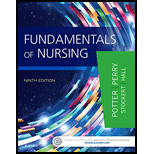
(a)
To determine:
Make a case for the applicability of grand theories (in modern nursing) and define in what way the healthcare provider can apply the original theory of nursing (Nightingale’s environmental theory) in the critical care unit setting.
Introduction:
A nursing class is conducting a conversation about the usefulness of grand theories. Make a case for the applicability of grand theories (in modern nursing) and define in what way the healthcare provider can apply the original theory of nursing (Nightingale’s environmental theory) in the critical care unit, emergency department, and home health.
(a)
Explanation of Solution
Grand theories are broad in scope, abstract, and complex. Hence, they need to clarify through research. So, that it can be practiced to nursing care. It does not offer directions for particular interventions of nursing rather; it delivers the framework (structural) for global thoughts about nursing. The application of Nightingale’s theory in the critical care unit is described below.
Critical care unit:
In the critical care unit, there may be chances for patient’s disorientation due to noise and continual actions. The health care providers should dim the light (for quiet periods) and regulate the noises. They can provide music therapy that may help the patient and their family to get relaxation.
(b)
To determine:
Make a case for the applicability of grand theories (in modern nursing) and define in what way the healthcare provider can apply the original theory of nursing (Nightingale’s environmental theory) in the emergency department (ED).
Introduction:
A nursing class is conducting a conversation about the usefulness of grand theories. Make a case for the applicability of grand theories (in modern nursing) and define in what way the healthcare provider can apply the original theory of nursing (Nightingale’s environmental theory) in the critical care unit, emergency department, and home health.
(b)
Explanation of Solution
The application of Nightingale’s theory in the emergency department is described below:
Nurses play an important role in the emergency department by inhibiting contamination (by body fluids) and regulating a hygienic environment. This is achieved by directing the sanitary worker to clean the floor using disinfectant, changing the bed and bed spreads regularly.
(c)
To determine:
Make a case for the applicability of grand theories (in modern nursing) and define in what way the healthcare provider can apply the original theory of nursing (Nightingale’s environmental theory) in home health.
Introduction:
A nursing class is conducting a conversation about the usefulness of grand theories. Make a case for the applicability of grand theories (in modern nursing) and define in what way the healthcare provider can apply the original theory of nursing (Nightingale’s environmental theory) in the critical care unit, emergency department, and home health.
(c)
Explanation of Solution
The application of Nightingale’s theory in the home health setting is described below,
In the home setting, a health care provider ensures that patients have a clean, safe, and clutter-free atmosphere and also evaluate for clean food, water, clothing, shelter, and medical supplies. The healthcare provider promotes fresh air and sunlight for the patient (who are homebound) and also evaluate the sleeping patterns to ensure patient’s sufficient rest.
Want to see more full solutions like this?
Chapter 4 Solutions
Fundamentals of Nursing, 9e
- true or false any practice employee is authorized to and should communicate collection guidelines with practice?arrow_forwardrtrue or false equesting a listing of specific creditreferences during patient intake os an acceptable business practice?arrow_forwardgive an overview on the respiratory assessmentarrow_forward
- explain an abdominal exam?arrow_forwardDiscuss β -Lactam antibiotics under the following subheadings Classifications of penicillins Classification of Cephalosporins General Mechanism of Actions Clinical Indications of penicillins and cephalosporins Adverse effects of β-lactamsarrow_forwarda. Define neoplasm b. Differentiate between benign and malignant tumours c. Describe the molecular basis of cancerarrow_forward
- differentiate the extra heart sounds S3,S4, murmurs and gallopsarrow_forward• Define shock and list types of shock • Discuss pathogenesis of septic shock. • Enumerate the stages of shock. • Define oedema and describe the pathophysiologic mechanisms of oedema with examples.arrow_forwardDiscuss Hypertension under the following headings: Definition Diagnosis Non-pharmacological intervention Drugs Classification Management of a Hypertensive emergencyarrow_forward
- Explain how the answer could be 2 or 1.8 WITHOUT changing the questionarrow_forwardoverview of the neurological system, cranial nerves and what part of the body it innervatesarrow_forwarddifferentiate structure and function of the peripheral vascular system. what are the normal and abnormal findings of the peripheral arterioles and peripheral venous systemarrow_forward
 Phlebotomy EssentialsNursingISBN:9781451194524Author:Ruth McCall, Cathee M. Tankersley MT(ASCP)Publisher:JONES+BARTLETT PUBLISHERS, INC.
Phlebotomy EssentialsNursingISBN:9781451194524Author:Ruth McCall, Cathee M. Tankersley MT(ASCP)Publisher:JONES+BARTLETT PUBLISHERS, INC. Gould's Pathophysiology for the Health Profession...NursingISBN:9780323414425Author:Robert J Hubert BSPublisher:Saunders
Gould's Pathophysiology for the Health Profession...NursingISBN:9780323414425Author:Robert J Hubert BSPublisher:Saunders Fundamentals Of NursingNursingISBN:9781496362179Author:Taylor, Carol (carol R.), LYNN, Pamela (pamela Barbara), Bartlett, Jennifer L.Publisher:Wolters Kluwer,
Fundamentals Of NursingNursingISBN:9781496362179Author:Taylor, Carol (carol R.), LYNN, Pamela (pamela Barbara), Bartlett, Jennifer L.Publisher:Wolters Kluwer, Fundamentals of Nursing, 9eNursingISBN:9780323327404Author:Patricia A. Potter RN MSN PhD FAAN, Anne Griffin Perry RN EdD FAAN, Patricia Stockert RN BSN MS PhD, Amy Hall RN BSN MS PhD CNEPublisher:Elsevier Science
Fundamentals of Nursing, 9eNursingISBN:9780323327404Author:Patricia A. Potter RN MSN PhD FAAN, Anne Griffin Perry RN EdD FAAN, Patricia Stockert RN BSN MS PhD, Amy Hall RN BSN MS PhD CNEPublisher:Elsevier Science Study Guide for Gould's Pathophysiology for the H...NursingISBN:9780323414142Author:Hubert BS, Robert J; VanMeter PhD, Karin C.Publisher:Saunders
Study Guide for Gould's Pathophysiology for the H...NursingISBN:9780323414142Author:Hubert BS, Robert J; VanMeter PhD, Karin C.Publisher:Saunders Issues and Ethics in the Helping Professions (Min...NursingISBN:9781337406291Author:Gerald Corey, Marianne Schneider Corey, Cindy CoreyPublisher:Cengage Learning
Issues and Ethics in the Helping Professions (Min...NursingISBN:9781337406291Author:Gerald Corey, Marianne Schneider Corey, Cindy CoreyPublisher:Cengage Learning





